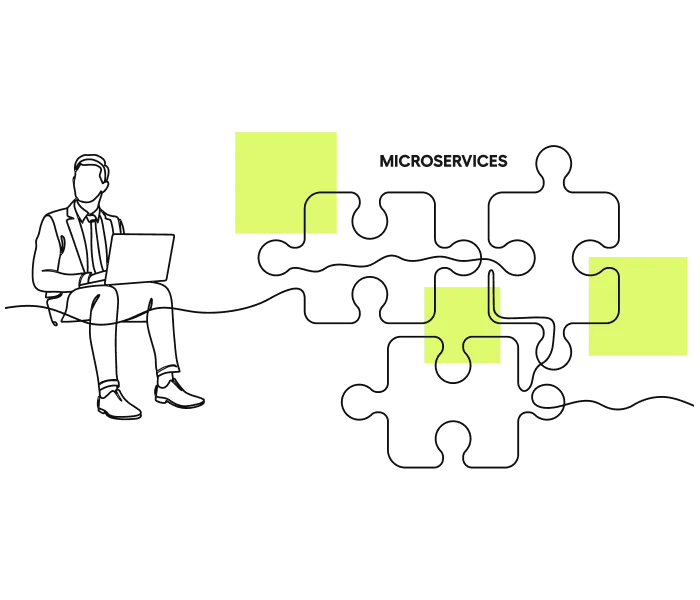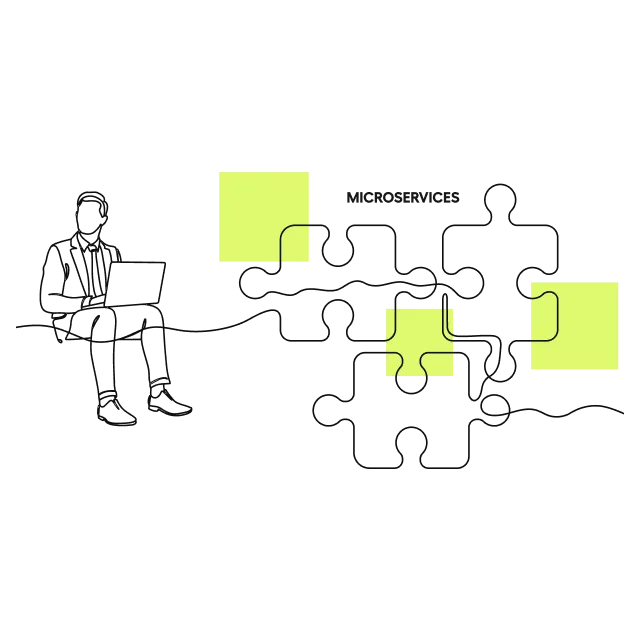

Microservices development
Microservices - grow
and enhance your
online store
Discover an architecture that supports the scalability of your platform and ensures its smooth operation at all times - choose microservices.
Imagine all your belongings are in one box, which becomes cumbersome over time. You decide to organize them into categories in smaller boxes. How does this example relate to technology and eCommerce?
This is exactly the approach that microservices architecture presents - it divides the entire system into smaller, independent components, such as deliveries, payments, customer service, called microservices. Each of them has its own set of features, a separate database, and operates independently of each other, while simultaneously creating a cohesive and efficient ecosystem, such as an online store.
Microservices offer:
- division of the system into smaller components,
- flexibility in scaling the e-store,
- the ability to combine various technologies.
Why Microservices - what sets microservice architecture apart?
Wondering what the actual effects of implementing microservices will bring to you? The advantage of this architecture over others (such as the traditional monolithic one, where all functionalities are combined into one system) can be summed up in 3 words: scalability, independence and performance. Find out what lies beneath each of these!
01/Scalability
Microservices will handle variable conditions in your eCommerce store. Increasing traffic, expanding offerings, or new sales markets - the scalability of microservices allows for flexible expansion of the store, element by element, without the need to disrupt all areas of the platform at once.
02/Independance
The independence of microservices is not only about the autonomous functioning of each component. It also entails freedom in choosing individual solutions both in terms of providers and technologies. This enables you to quickly adapt to dynamic market changes, freely combining various solutions.
03/Performance
Thanks to performance optimization (including its own database), each service operates quickly and smoothly, eliminating delays or downtime. The short loading time of the platform positively influences the shopping experience of customers, ultimately resulting in higher conversion rates and greater profits.
When is it worth opting for a microservices architecture?
Your sales platform is gaining new customers, so over time, you expand the store's offerings, add new features, or perhaps even start selling in new markets. In each of these cases, microservices will prove to be the appropriate architecture for you. However, these are not the only cases in which it's worth considering this solution.
Microservices, due to their flexibility, address various and often unexpected needs of entrepreneurs (such as rapid implementation of new features or unexpected server load). In short - thanks to them, your online store will be ready for any eventuality!
Increasing customers
Business expansion
Changing trends
Features development
New business goals
Microservices - deliver unlimited possibilities to your eCommerce
Dividing the platform into microservices is not only about easier daily store management. It's also an opportunity to scale your business, implement innovations faster, and build a competitive advantage. Discover what else you can gain with microarchitecture!

the failure of one microservice does not result in the complete shutdown of the platform, ensuring continuity of store operation.

microservices allow independent updates of different parts of the eCommerce store, enabling a rapid response to changes.

smooth and fast operation provides customers with comfortable experiences and increases their satisfaction, improving conversion rates.

you don't have to invest in expanding the entire platform; you can focus on developing selected features that bring the greatest benefits.

microservices support international sales by facilitating the smooth implementation of different currencies, languages, and adapting the store to various types of customers.

the architecture allows for adding new store features through integration with external systems regardless of technologies, such as chatbots or CMS-type systems.
Microservices - deliver unlimited possibilities to your eCommerce

Quickly and efficiently - 5 steps to implement microservices
Do you already have a store built according to the monolithic concept and are considering migrating to microservices? Or perhaps you would like to build an entirely new platform from scratch using microservices? In both cases, you may wonder how the process of implementing microarchitecture actually works.
At Advox, we focus on a simple and transparent implementation process, ensuring that we meet your expectations, and you can quickly reap the benefits of our work. Will you take the first step towards microservices with us?
We won't leave you without answers to important questions about microservices...
The simplest definition of microservices suggests they are independent components of a system, enabling work on specific functionalities of an online store. Each of these components operates autonomously, handling various services (such as payments, orders, product management) and using its own database. Thanks to them, different parts of the system can be designed and implemented independently, allowing for flexible technology adaptation and enhancing user experience quality.
Microservices offer numerous benefits for online store owners. They allow for business scaling and continuous development, enable the use of multiple technologies simultaneously, and enhance security. Additionally, their utilisation reduces technological debt and increases system stability (preventing overall system failures). However, it's essential to design the microservices division thoughtfully. Errors in the project can increase its complexity and make implementing changes involving multiple processes more difficult. Therefore, when implementing microservices, it's worthwhile to seek assistance from experienced specialists.
Microservices communicate through Application Programming Interfaces (APIs), which act as a connection between individual components, facilitating efficient data exchange (both synchronous and asynchronous). APIs define the rules and communication standards between services, enabling their collaboration even with different programming languages and technologies. In practice, various types of APIs are utilized, such as RESTful API, GraphQL, or SOAP - all tailored to specific project needs and requirements.
Individual components within microservices can be written in different programming languages. The architecture's flexibility allows for a flexible selection of the technological stack depending on needs or individual preferences. The most commonly used programming languages for building microservices include Python, PHP, Java, JavaScript, C#, and frameworks such as Symfony, Spring Boot, Flask, or Express.js.
In the case of an e-commerce store, the choice between monolithic and microservices architecture largely depends on business needs. Monolith works best in the initial phase of operations when development directions are still unknown, or in a small business that handles relatively few processes. On the other hand, microservices will be more preferred when aiming for business scalability and system flexibility, allowing for autonomous development of individual elements.
It's also essential to remember that there is always the possibility of migrating to another architecture in the future, but in the long term, this may be a more costly and time-consuming process.
At Advox, for over 10 years, we have specialised in creating online stores for clients from various industries (B2B and B2C). This extensive experience has not only enabled us to develop a roven working system, valued by our clients, but also gain in-depth knowledge about the eCommerce industry and understand the changes occurring within it.
On a daily basis, we work with various technologies, such as Python or Symfony (which are excellently suited for microservices architecture), and our programmers and project managers hold certificates confirming their knowledge of the solutions used. In short - we know how to create a project that meets your expectations.
Discover benefits of microservices
Write us



